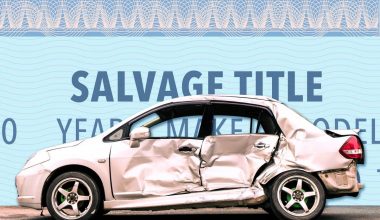When it comes to car insurance, there is a lot to think about. When evaluating auto insurance coverage, you must consider not just the premium expenses, but also your deductible.
Deductibles are important to consider for a variety of reasons. To begin, you may wind up paying the deductible for your policy at any time, so it must be one you can afford. Furthermore, the deductible you select may have a direct impact on the amount you pay for car insurance premiums. It may be tempting to overlook the deductible amount when purchasing insurance coverage, but it may be a more crucial consideration than you realize. Here we’ll see how car insurance deductibles work.
What is a Car Insurance Deductible?
A car insurance deductible is the sum of money you agree to pay out of pocket for car repairs or replacements following an accident. If you are in an accident that causes $5,000 in damage to your vehicle and you have a $500 deductible, the insurance company should pay $4,500 of the claim while you are responsible for the remaining $500.
Before concluding your auto insurance coverage, you will discuss your insurance deductible amount with your insurance agent or carrier. You should, however, be able to adjust your deductible at any time.
How Does Car Insurance Deductible Work?
Car insurance deductibles work as a requirement for submitting certain types of claims, preventing policyholders from filing bogus claims by requiring them to pay a percentage of the cost upfront. When acquiring an insurance policy, the policyholder selects and agrees on deductible amounts.
Most car insurance providers simply deduct the deductible amount from your claim reimbursement. For example, if your mechanic costs you $3,000 for repairs and you have a $500 deductible, your insurer will send you a check for $2,500 to cover the cost.
Deductibles work the same way for all types of car insurance coverage that use deductibles. Furthermore, car insurance deductible work in the same way as deductibles for health insurance, homeowners insurance, and business insurance.
What Types of Car Insurance Deductibles are Available?
Your auto insurance policy is a collection of various coverages. Some coverages, including liability, pay the other party for injuries and damages if you are at fault in an accident. Other coverages, like comprehensive, collision, personal injury protection, and uninsured motorist property damage, are available to assist cover injuries to passengers and damage to your vehicle. These coverages may include deductibles or the opportunity to include deductibles to minimize the cost of coverage.
Here are a few examples of coverages that typically include a deductible or the ability to select one:
#1. Collision
Optional collision coverage covers car damage caused by a collision with an object (such as a telephone pole, guard rail, mailbox, or structure) when you are at fault. While collision coverage does not cover mechanical breakdown or normal wear and tear on your vehicle, insurance does cover damage caused by potholes or rolling your vehicle.
According to the Insurance Information Institute, the average cost of collision coverage is around $300 per year (Triple-I). If you file a claim for car damage under collision coverage, your policy’s deductible will be applied.
#2. Comprehensive
Optional comprehensive coverage protects your car against theft and damage caused by an incident other than a collision. This covers threats such as fire, flood, vandalism, hail, falling rocks or trees, and hitting an animal.
According to Triple-I, the average annual cost of comprehensive coverage is less than $200. If you file a claim for car damage under comprehensive coverage, your policy’s deductible will be applied.
While there are numerous situations in which a deductible may be applicable, there are some in which your comprehensive deductible may not apply. In Florida, Kentucky, and South Carolina, for example, if you have a chip or crack in your windshield, your insurer will restore it with no deductible. Some insurers provide zero-deductible comprehensive coverage, which means that if you file a claim for any comprehensive damage, you will not have to pay anything, but your premium will be greater.
#3. Property damage caused by uninsured/underinsured motorists
If you are involved in an accident with an uninsured or underinsured driver, if the driver does not have enough coverage to pay for the damage to your car, or if the driver flees, you may be entitled to file a claim under your uninsured/underinsured motorist property damage coverage. This coverage is not accessible in every state, but in those where it is, it may have a state-mandated deductible amount. When a deductible is required, it is usually low, ranging from $100 to $300.
#4. Personal injury insurance
Personal injury protection (PIP) coverage may be included in your policy depending on your state. This coverage contributes to the payment of medical bills for you and all passengers in your vehicle. It can also help cover expenditures such as missed wages or if you require someone to undertake domestic activities after an accident because you are unable to do so yourself. Depending on your state, you may be subject to a deductible if you file a claim under this coverage. Many states with PIP deductibles offer various alternatives, and the deductible you select can affect your rate.
What Types of Car Insurance Do Not Require a Deductible?
Most states mandate liability coverage, which helps cover injuries and property damage for the other party or parties if you are at fault in an accident. When you purchase liability insurance, you will select a specified amount of coverage. These are the maximum amounts that the insurance company will pay the other party for a covered claim. There is no deductible because liability coverage extends to others you injure or damage.
There is usually no deductible if you choose optional coverages like roadside assistance or rental car reimbursement, though there may be coverage limits and caps on the number of claims you can file for these add-ons.
What is the Average Car Insurance Deductible?
Many drivers have plans with $500 comprehensive and collision deductibles, but there are many different deductible options available. Your deductible selections will normally be determined by the auto insurance company and policy you are choosing. It’s also worth remembering that your comprehensive and collision deductibles do not have to match, and it’s fairly typical to have one deductible that is higher than the other.
In general, the bigger your comprehensive and collision deductibles, the lower your overall premiums. Your car insurance deductible will be determined by your budget and the amount you can afford to pay out of pocket if you need to file a claim for covered repairs to your vehicle.
Car insurance deductibles are often available in the following amounts:
- $0
- $100
- $250
- $500
- $1,000
- $1,500
- $2,000
- $2,500
When Do You Pay Deductible For Car Insurance?
You must pay your car insurance deductible if you cause an accident that damages your vehicle and submit a claim with your collision insurance. If you are at fault in an accident and are wounded, you must also pay a PIP deductible. In most cases, if you utilize your own insurance, you must pay a deductible, even if you are not at fault.
When You Must Pay Car Insurance Deductibles Examples
- When you use PIP insurance to pay your own medical expenditures, regardless of who is to blame.
- When you file a claim with your collision insurance after causing an accident.
- When you utilize your own comprehensive insurance to protect your vehicle.
- When employing uninsured motorist property damage insurance to cover car damage caused by an uninsured or underinsured driver.
- When there is a joint fault in an accident and you use your own insurance to pay vehicle damage and medical expenses.
When Is It Not Necessary To Pay Your Car Insurance Deductible?
There will be times when you are not required to pay your deductible, but these are rare. In most cases, you will not be obliged to pay your deductible if you:
- Another driver is to blame.
If another driver hits you and is insured, you should not be responsible for paying a deductible on the claim you make with their insurance carrier. Your deductibles only apply when you file a claim with your insurance company.
- If your deductible is decreasing,
Some insurance providers provide a decreasing or disappearing deductible option. If you have this policy provision, the longer you go without an accident, the less you will have to pay for your deductible. It is usually a $100 credit applied to your deductible amount for each year you are accident-free. For example, if you have a $500 collision deductible and do not have an accident for four years, you may be eligible for a $100 discount each year. If you ever needed to file a claim, your deductible would be $100 rather than the original $500. When you use your reducing deductible, there is normally a waiting period before you may use it again. Speak with your insurance agent or carrier representative to find out if this feature is available and what the eligibility requirements are.
Considerations When Selecting a Car Insurance Deductible
With so numerous deductible levels to pick from, you may be perplexed as to how to select the best one. When looking for a car insurance policy, keep the following points in mind:
#1. Do you want to pay less for car insurance or repairs?
A greater deductible will normally lower your insurance rate, but you will pay more out of pocket if you file a claim for vehicle damage. Some claims may even be covered by your deductible, in which case you must pay the entire amount out of pocket. For example, if you back into a tree and do $350 in damage to your vehicle, and your collision deductible is $1,000, you will have to pay for all repairs out of pocket.
If you choose a lower deductible, your car insurance premium will most certainly be higher, but you will incur fewer expenses if you submit a claim. If your deductible is $100 and you inflict $350 in damage by backing into a tree, you just have to pay your $100 deductible, while your insurance will pay the remaining $250. However, having a lower deductible may cause you to pay more in premiums while never filing a claim. This is the nature of insurance and an illustration of the risk that both you and the insurer assume.
#2. How much money can you afford to pay out of your own pocket?
Before deciding on a deductible, consider how much you can afford to pay if your car is damaged in an accident. If that sum is $500, you should generally not choose a deductible that is larger than $500. If you do, you may be unable to afford to repair your vehicle if you are at fault and must pay the deductible.
#3. Is there a deductible requirement with your lender?
If your vehicle is financed or leased, you will almost certainly need comprehensive collision coverage. If this is the case, you must select deductibles for each. Some lenders will enable you to carry a maximum deductible for comprehensive and collision coverage. It is critical to check with the financial organization handling your loan or lease to see if any limits apply.
Do You Pay a Deductible if You Hit Another Car?
If you are found to be at fault for an accident in which you hit another vehicle, your auto insurance policy contains a number of different types of coverage that could become active. Your bodily injury liability and property damage liability would pay for the damages to the other party as well as the damages to their vehicle, and there is no deductible associated with these types of coverage. If, on the other hand, you have collision coverage and you want the insurance company to pay for the repairs to your vehicle, you will be required to pay your collision deductible.
Is It Better to Have a $500 or $1,000 Deductible?
The vast majority of insurance professionals will advise you to select a deductible that you are confident you will be able to pay. If you want your monthly premium to be cheaper, you might think about raising your deductible if you have the money for it. On the other hand, if a deductible of $1,000 is not within your financial means, it may make more sense to choose a lower deductible and pay a higher premium. When deciding on a deductible, it is a good idea to take into account the value of your vehicle. For instance, if your vehicle only has a value of $1,500, setting a deductible of $1,000 means that your insurance company may only be responsible for up to $500 worth of damages to your vehicle in the event of an accident.
What Is a Collision Insurance Deductible?
When filing a claim for collision insurance, the driver is required to pay a certain amount of money out of their own pocket, which is known as the collision insurance deductible. If a driver causes an accident that damages their vehicle, the driver’s collision insurance will pay to repair or replace the vehicle. However, the driver is responsible for paying their collision deductible before their insurance company will cover the remaining costs.
What Is a Good Deductible for Car Insurance?
Your comprehensive deductible should typically be somewhere between $100 and $500, according to the recommendations of most insurance agents. Claims for comprehensive coverage are typically filed for less damage than collision claims, so it makes sense to have a lower deductible for comprehensive coverage.
What if Damage Is More Than Deductible?
If the amount of your damages is greater than the amount of your deductible, the insurance company will pay the remaining balance, up to the amount that you have coverage for. You are the one who determines the amount of your deductible as well as the limits of your coverage, and you are responsible for making payments equal to the deductible amount before your insurance company begins to pay for the remaining balance.
Is It Good to Hit Deductible?
Yes. It is important to keep track of the numbers, as your deductible will be recalculated at the beginning of each plan year. If you have already met your deductible for the year or are very close to meeting it, you should consider completing any remaining exams or procedures before the end of your plan year in order to reduce the amount of money you will have to pay out of pocket.
Conclusion
The basic conclusion is that selecting the appropriate deductible takes time and thought. A professional insurance agent can assist consumers in making the best option based on their driving history, present financial situation, credit history, and overall financial planning objectives.
Car Insurance Deductible FAQs
What is a good deductible for car insurance?
Insurance agents typically recommend that your comprehensive deductible be between $100 and $500. Because comprehensive claims are typically filed for less damage than collision claims, having a lower deductible is generally appropriate.
Do you pay your deductible after your car is fixed?
Your car insurance company will usually work directly with the repair facility. You would pay your deductible to the repair shop once the repairs were completed. You cannot pay your deductible over time unless the repair shop offers a payment plan.
What happens if you don't meet your deductible?
If you do not meet the bare minimum, your insurance will not pay for deductible-related charges. Nonetheless, even if you do not reach the minimal criterion, you may receive other benefits from the insurance.
Related Articles
- COLLISION INSURANCE: Meaning & Coverages
- Car Accident Lawyer: Fees and How they Work
- Best National General Health Insurance Reviews 2023 Login, Phone number, Pros, and Cons
- 6 Responsibilities of a Personal Injury Lawyer
- Cheapest No Down Payment Car Insurance In 2023






